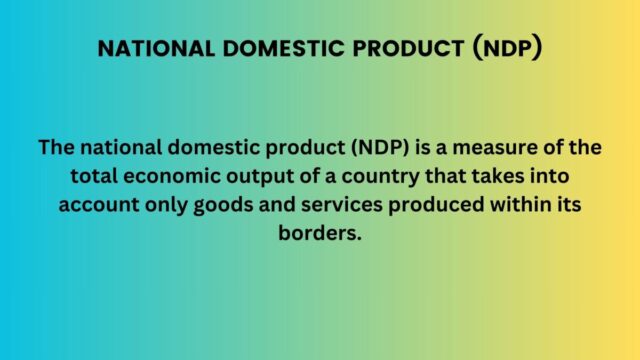National Domestic Product (NDP): Calculation, Limitations and Significance [Updated 2024]

The national domestic product (NDP) is a measure of the total economic output of a country that takes into account only goods and services produced within its borders. It is similar to gross domestic product (GDP) but excludes the depreciation of capital assets, such as machinery and equipment, which is accounted for in gross domestic product (GDP). This exclusion makes NDP a more accurate measure of a country’s economic performance in terms of its ability to maintain and improve its capital stock over time.
Components of National Domestic Product
Consumption (C): This component represents the total expenditure by households on goods and services for consumption purposes. It includes expenditures on durable goods (such as cars and appliances), non-durable goods (such as food and clothing), and services (such as healthcare and education).
Investment (I): Investment refers to spending on capital goods that will be used in the production process. It includes purchases of machinery, equipment, and structures by businesses, as well as residential construction and changes in business inventories.
Government Spending (G): Government spending includes all expenditures by federal, state, and local governments on goods and services. It encompasses spending on defense, education, healthcare, infrastructure, and other public goods and services.
Net Exports (NX): Net exports represent the difference between a country’s exports and imports. If a country exports more goods and services than it imports, it has a trade surplus, and net exports contribute positively to NDP. Conversely, if imports exceed exports, the country has a trade deficit, and net exports detract from NDP.
Calculating National Domestic Product
NDP can be calculated using the following formula: [ NDP = C + I + G + NX ]
Where:( C ) = Consumption, ( I ) = Investment, ( G ) = Government Spending, ( NX ) = Net Exports
Importance of National Domestic Product (NDP)
Economic Performance: NDP provides a comprehensive measure of a country’s economic performance by capturing the total value of goods and services produced within its borders.
Policy Evaluation: Governments use NDP data to evaluate the effectiveness of economic policies and make informed decisions regarding fiscal and monetary measures to stimulate economic growth or stabilize the economy.
International Comparisons: NDP allows for comparisons of economic performance between countries, enabling policymakers, investors, and analysts to assess relative strengths and weaknesses.
Standard of Living: Changes in NDP over time can reflect improvements or declines in the standard of living within a country, as higher NDP typically correlates with increased income and consumption opportunities for citizens.
Limitations of National Domestic Product (NDP)
Excludes Informal Economy: NDP may underestimate the true economic activity within a country since it only accounts for formal sector transactions. Informal sector activities, such as street vendors and unregistered businesses, are not included in NDP calculations.
Ignores Non-Market Transactions: Certain valuable activities, such as household production and volunteer work, are not captured in NDP calculations since they do not involve monetary transactions.
Quality of Life Indicators: NDP does not provide a comprehensive measure of overall well-being or quality of life since it focuses solely on economic output. Other indicators, such as income distribution, health outcomes, and environmental sustainability, are also important considerations.
Doesn’t Account for Externalities: NDP does not account for negative externalities, such as pollution and environmental degradation, which can impact long-term sustainability and societal welfare.
Conclusion
National domestic product (NDP) is a vital economic indicator that measures the total economic output of a country, excluding the depreciation of capital assets. By capturing consumption, investment, government spending, and net exports, NDP provides insights into a nation’s economic performance, policy effectiveness, and standard of living.
However, it is essential to recognize the limitations of NDP and supplement its analysis with other indicators to gain a comprehensive understanding of an economy’s health and well-being.






